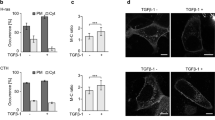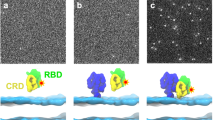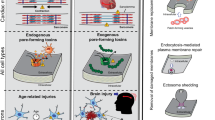Abstract
To examine the ability of ras to activate signal transduction pathways in the absence of lipid modifications, fusion proteins were constructed that target rasWT or activated ras61L to cellular membranes as integral membrane proteins, using the first transmembrane domain of the E1 protein of avian infectious bronchitis virus (IBV), which contains a cis-Golgi targeting signal. Golgi-targeted derivatives of activated ras were completely inactive in transformation assays. However, when examined in focus formation assays, transformation of NIH3T3 cells were seen with derivatives of ras61L containing a mutated E1 targeting sequence that results in plasma membrane localization. Removal of the lipid modification sites in and upstream of the CAAX motif did not abrogate the transforming activity of plasma membrane-localized ras61L derivatives, indicating that these lipid modifications are not essential for ras activity, as long as the protein is correctly localized to the plasma membrane. Interestingly, the activity of integral membrane versions of ras61L was strictly dependent on a minimum distance between the transmembrane domain anchor region and the coding sequence of ras. Derivatives with only a 3-amino acid linker were inactive, while linkers of either 11- or 22-amino acids were sufficient to restore transforming activity. These results demonstrate that: (1) activated ras targeted to Golgi membranes is unable to cause transformation; (2) lipid modifications at the C-terminus are not required for the transforming activity of plasma membrane-anchored ras61L derivatives, and serve primarily a targeting function; (3) a transmembrane domain can effectively substitute for C-terminal modifications that would normally target ras to the inner surface of the plasma membrane, indicating that ras61L does not need to reversibly dissociate from the membrane as might be allowed by the normal lipidation; and (4) in order to function properly, there exists a critical distance that the ras protein must reside from the plasma membrane.
Similar content being viewed by others
Article PDF
Author information
Authors and Affiliations
Rights and permissions
About this article
Cite this article
Hart, K., Donoghue, D. Derivatives of activated H-ras lacking C-terminal lipid modifications retain transforming ability if targeted to the correct subcellular location. Oncogene 14, 945–953 (1997). https://doi.org/10.1038/sj.onc.1200908
Received:
Revised:
Accepted:
Issue date:
DOI: https://doi.org/10.1038/sj.onc.1200908
Keywords
This article is cited by
-
RAS at the Golgi antagonizes malignant transformation through PTPRκ-mediated inhibition of ERK activation
Nature Communications (2018)
-
Ras proteins: different signals from different locations
Nature Reviews Molecular Cell Biology (2003)
-
Transformation and Stat activation by derivatives of FGFR1, FGFR3, and FGFR4
Oncogene (2000)
-
Structure and function of the C-terminal hypervariable region of K-Ras4B in plasma membrane targetting and transformation
Oncogene (2000)



